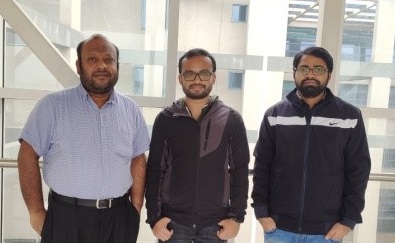Mr. Gautam Kumar obtained his M. Tech (Chemical Science and Technology) degree from DIAT(DU)-DRDO-Pune in 2018. He joined the IC research group under the guidance of Prof. Dr. Indranil Chatterjee in July 2018 at Indian Institute of Technology, Ropar, India as a Ph.D. student. He is working on the methodology developments for organic synthesis.
Mr. Sourav Roy completed his Masters at Bidhannagar Govt. College, Bidhannagar, West Bengal State University in 2017. He joined the IC research group under the guidance of Prof. Dr. Indranil Chatterjee in July 2018 at Indian Institute of Technology, Ropar, India as a Ph.D. student. He is working on the methodology developments in organic synthesis.
Dr. Indranil Chatterjee was born in Kolkata, India in 1983. He obtained his B.Sc. from Calcutta University, India in 2006, before joining IIT Kharagpur for his M.Sc. study. In 2008 he moved to Germany for his Ph.D. study at Westfälische Wilhelms-University Muenster under the guidance of Prof. Dr. Armido Studer. After finishing his Ph.D. study in November 2011, he became a Postdoctoral fellow in the group of Prof. Paolo Melchiorre in ICIQ, Tarragona, Spain. From 2014 to 2016, he was a Post-Doc with Prof. Martin Oestreich at the Technische Universität Berlin. He is currently an Assistant Professor at the Indian Institute of Technology Ropar, India.
What inspired you to write this Review article?
The wondrous reactivity of BCF prompted us to work in this field. The versatile capability of BCF is not only restricted to FLP catalysis but extends as a potential Lewis acid to develop verities of transition-metal-free transformation. Therefore, we thought compiling all recent reports in a single frame would be beneficial to the synthetic chemistry community and to new readers looking to develop innovative synthetic methodologies and do more exploration in this blooming area of catalysis.
What primary research are you carrying out in the area?
We started our journey in the field of BCF catalysis in 2018. We were able to successfully develop“Boron Lewis Acid-Catalyzed Regioselective Hydrothiolation of Conjugated Dienes with Thiols” (ACS Catal. 2019, 9, 12, 11627–11633). This unique and high regioselectivity prompted us to explore various regioselective C−heteroatom bond forming reactions using BCF catalysis as an ongoing project.
What are your thoughts on the future of this research field?
This review collectively highlights the recent development and displays a strong prospective towards a new direction for further discovery and sustainable synthesis in this area. We hope this reactivity can be a potential alternative for transition-metal-based catalysts to discover numerous synthetic protocols in the near future with industrial applications. We expect that BCF chemistry will be explored in various C−H bond functionalization strategies and utilized as a co-catalyst in numerous asymmetric transformations.
Read the full article: Tris(pentafluorophenyl)borane Catalyzed C−C and C−heteroatom Bond Formation
See the other articles showcased in this month’s Editor’s Collection
See all the full articles on our publishing platform











